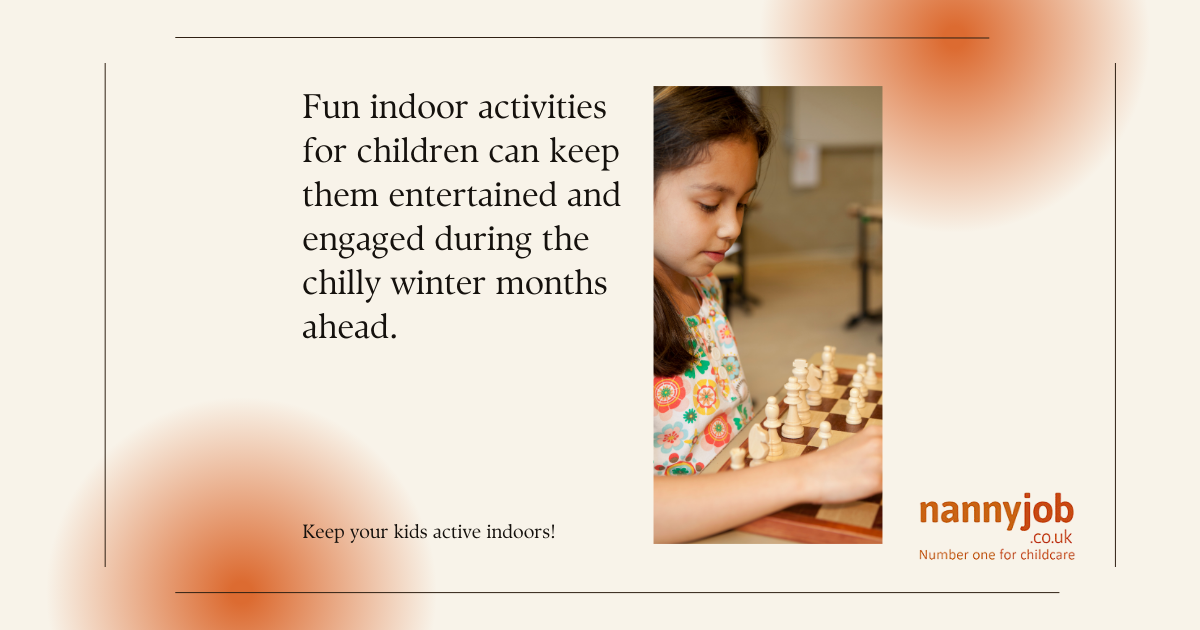Introduction
As winter rolls in and temperatures drop, outdoor play may be limited, but that doesn’t mean the fun has to stop! Cold days offer the perfect opportunity to get creative and keep children entertained, learning, and active indoors. Here’s a list of indoor activities to make the most of winter days, ensuring kids stay engaged, happy, and cozy.
1. Get Crafty with DIY Art Projects
Crafting is a wonderful way for children to explore their creativity, and winter provides ample inspiration! Art projects help develop fine motor skills and allow children to express themselves.
- Winter Collage: Gather paper, cotton balls, glitter, and colored markers, and have children create snowy scenes or winter animals.
- Salt Dough Ornaments: Make salt dough using flour, salt, and water, then shape it into winter-themed decorations to bake and paint.
- Snowflake Cutouts: Use folded paper to create snowflakes, helping children learn about symmetry while making unique designs.
Tip: Display their artwork around the home for a festive and personal touch.
2. Baking and Cooking Together
Baking is a fun, hands-on activity that teaches children basic cooking skills, counting, and following instructions. Plus, you get delicious treats as a reward!
- Decorate Cookies: Bake simple sugar cookies and let children decorate them with frosting, sprinkles, or edible glitter.
- Hot Chocolate Bar: Set up a DIY hot chocolate station with marshmallows, whipped cream, and chocolate chips for a cozy treat.
- Bake Banana Bread or Muffins: These simple recipes are easy for kids to help with and are delicious on chilly days.
Tip: Encourage children to measure ingredients, mix batter, and learn about the process of baking while building confidence in the kitchen.
3. Create a Cozy Reading Nook
Encouraging reading helps foster a lifelong love for books, and a cozy winter day is perfect for storytime. Create a reading nook with blankets, pillows, and a small stack of books to keep children entertained.
- Storytime Adventures: Choose winter-themed stories, fairy tales, or adventure books to spark imagination.
- Reading Challenge: Start a “winter reading challenge” with small rewards for each book or chapter completed.
- Audiobook Fun: If children are too young to read alone, try listening to audiobooks together while looking through picture books.
Tip: Add a flashlight or small lamp to create a “campfire” feel, adding excitement to indoor reading sessions.
4. Build a Fort or Indoor Tent
Building a fort is a classic winter activity that never gets old. Fort-building encourages creativity, problem-solving, and teamwork, while creating a special place for children to relax and play.
- Blanket Fort: Use blankets, pillows, and chairs to create a cozy fort. Add fairy lights or flashlights to make it extra magical.
- DIY Tent: Hang a bedsheet over a clothesline or other support to create a simple indoor tent.
- Themed Play: Turn the fort into a pretend space, like a pirate ship, castle, or winter cabin, for imaginative play.
Tip: Stock the fort with books, toys, or snacks so children can enjoy their hideaway throughout the day.
5. Indoor Obstacle Course
An obstacle course is a great way to keep children active, even when stuck indoors. It’s an excellent activity to burn off energy and improve motor skills.
- Use Pillows and Cushions: Create “stepping stones” or “hurdles” with pillows, cushions, and chairs.
- Tunnel and Crawl Spaces: Use blankets or cardboard boxes to make tunnels for children to crawl through.
- Jump and Balance: Encourage balancing on pillows, hopping over small objects, or crawling under tables.
Tip: Make it a timed challenge or add fun instructions like “hop like a bunny” or “balance like a flamingo” to keep it interesting.
6. Science Experiments at Home
Simple science experiments can be a fun and educational way to explore the world indoors. They teach children about cause and effect, observation, and problem-solving.
- Baking Soda and Vinegar Volcano: Use baking soda, vinegar, and food coloring to create a “volcano” in a bowl.
- Ice Melting Experiment: Freeze small toys or objects in a block of ice, then have children experiment with warm water, salt, or sugar to see what melts the ice fastest.
- Rainbow Milk: Add drops of food coloring to milk in a dish, then dip a cotton swab in dish soap and touch it to the colors to create a “rainbow” effect.
Tip: Explain the science behind each experiment in simple terms, helping children understand the wonders of chemistry or physics.
7. Dance Party or Movement Games
Sometimes, the best way to beat the winter blues is to get moving! An indoor dance party or fun movement games will keep children active, help release energy, and lift everyone’s spirits.
- Dance Party: Play a playlist of favorite songs or kid-friendly dance music, and have a mini dance party in the living room.
- Freeze Dance: Start the music, and when it stops, everyone has to freeze in place. This is a fun way to practice balance and listening skills.
- Yoga for Kids: Simple yoga poses are great for stretching and relaxing. Look for kid-friendly yoga videos or make up poses together.
Tip: Create themed dance parties (like a disco party or pajama party) to make it extra fun and memorable.
8. Interactive Storytelling and Puppet Shows
Encourage imaginative play with interactive storytelling or a puppet show. Children can create characters, invent dialogue, and act out stories, building creativity and communication skills.
- Puppet Show: Use hand puppets, finger puppets, or DIY sock puppets to act out a story.
- Story Circle: Begin a story and have each person add a line or two, creating a collaborative tale.
- Dress-Up Play: Use costumes or props to act out favorite stories or make up new ones.
Tip: Set up a “stage” with a curtain or a blanket, making the storytelling experience even more exciting for kids.
9. Board Games and Puzzles
Board games and puzzles are excellent for improving children’s problem-solving abilities, focus, and teamwork. Plus, they’re a fun way to bond with the whole family.
- Classic Board Games: Choose games that are age-appropriate, like Snakes and Ladders, Connect Four, or Memory Match.
- Puzzles: Puzzles improve patience and problem-solving. You can work on one large puzzle together or have multiple small ones for kids to complete on their own.
- Card Games: Simple card games like Go Fish, Crazy Eights, or Snap are easy to learn and play indoors.
Tip: Encourage friendly competition and teach children about good sportsmanship by playing games as a family.
10. Indoor Scavenger Hunt
A scavenger hunt is a fun way to keep children active and engaged without needing much space. Create a list of items for children to find around the house and let the adventure begin.
- Themed Hunts: Create a winter-themed hunt where children search for items like “something white,” “something cozy,” or “something that smells nice.”
- Hidden Treasures: Hide small treats, toys, or notes for them to find, adding excitement to each discovery.
- Checklist Hunt: Give children a list of things to find or actions to complete (like “find a red item” or “do 10 jumping jacks”).
Tip: Add clues or riddles to make it a bit more challenging for older children.
Conclusion
Winter days don’t have to mean boredom or inactivity. With these indoor activities, you can turn chilly days into fun, learning-filled experiences that keep children entertained, active, and engaged. From crafting and baking to dancing and storytelling, there’s a world of adventure to enjoy indoors. So, embrace the cozy season and enjoy the endless possibilities for creativity and play with your little ones!










